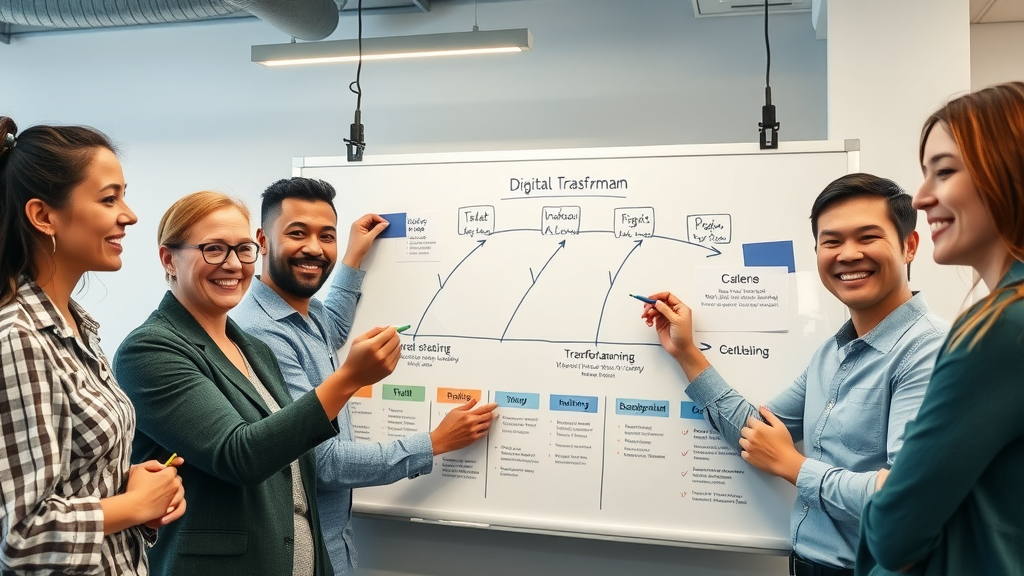Did you know that only 11% of nonprofit organizations describe themselves as “highly effective” in adopting new technologies—yet more than 80% believe digital transformation is critical for their future? As digital demands soar and donor expectations rise, technology adoption challenges in nonprofits are more urgent and complex than ever. If you’re struggling to keep up, you’re not alone. This guide unlocks practical approaches, expert strategies, and actionable insights to help you overcome the digital hurdles facing modern nonprofits—empowering your mission and your team for lasting impact.
Unlocking the Potential: Understanding Technology Adoption Challenges in Nonprofits
Many nonprofit organizations recognize the need for innovation but quickly discover there’s a gap between knowing and doing. Technology adoption challenges in nonprofits aren’t just about purchasing new tools—they’re about transforming how organizations serve their communities, engage donors, and manage data. With tight budgets, limited staff, and ever-changing donor needs, organizations face real obstacles when trying to modernize processes and systems. Yet, embracing tech innovation and digital transformation can enhance operational efficiency, save precious time and resources, and push your mission further than previously possible.
To highlight the urgency: According to recent studies, over 60% of nonprofit leaders report that outdated technology negatively impacts their daily operations and donor management. This striking figure reinforces how essential technology investment is for ongoing success. The reality is that the nonprofit sector is no longer insulated from the sweeping impact of technological advancement. Instead, every organization must meet the moment by addressing digital adoption directly, creatively, and proactively. Let’s explore what this journey looks like—and how to avoid common pitfalls along the way.

- Fact: Nearly 60% of nonprofit organizations are accelerating digital transformation to meet donor expectations and streamline operations, but technology adoption remains a top challenge.
Digital Transformation in Nonprofit Organizations: The New Frontier
The digital era is redefining how nonprofits operate, connect with donors, and deliver services. Digital transformation involves integrating digital tools—such as management software, mobile apps, and cloud-based platforms—into every aspect of a nonprofit’s operations. This isn’t just a matter of switching from manual work to electronic records; it’s about enabling strategic decision-making, optimizing program delivery, and deepening donor relationships. For many, the transformation brings about increased operational efficiency, transparency, and the power to achieve their mission on a larger scale.
However, maximizing benefits from digital transformation is not without hurdles. Nonprofit organizations often find that integrating sophisticated project management systems or donor management software stretches both their technical skills and their budget. Moreover, staff must adapt to new processes and workflows—all while sustaining daily operations and serving the community. Overcoming barriers to digital transformation requires a blend of vision, leadership, and creativity, but the payoff is a more agile, connected, and impactful organization.
Why Organizations Face Technology Adoption Challenges
It’s no surprise that technology adoption challenges in nonprofits stem from multiple sources. Financial barriers, such as limited budgets, restrict access to cutting-edge tools and necessary infrastructure upgrades. Nonprofit leaders are tasked with tough decisions: How can you allocate scarce resources between immediate program needs and the promise of greater efficiency through tech investment?
Human factors play a big role as well. Many teams resist change, unsure of new digital processes or wary of leaving behind established workflows. Furthermore, the rapid pace of technology trends—from artificial intelligence to the latest social media platforms—can overwhelm even the most forward-thinking organizations. These internal and external challenges mean that nonprofit organizations must be strategic, resourceful, and inclusive in their technology adoption efforts.
What You'll Learn: Navigating Technology Adoption Challenges in Nonprofits
- Practical strategies to address common technology trends and challenges faced by nonprofit organizations.
- Step-by-step guidance for improving data management, protecting donor information, and executing digital transformation.
- Tips for training staff, managing change, and building organizational readiness for new technologies.
Examining Key Technology Adoption Challenges in Nonprofits
Limited Budgets: Managing Technology Investment in Nonprofit Organizations
For most nonprofit organizations, every dollar counts. Limited budgets consistently top the list of technology adoption challenges in nonprofits. Budget constraints mean organizations face difficult trade-offs between investing in program delivery and upgrading essential technology. When leaders must choose between funding outreach services and purchasing new management systems, technology investment often takes a back seat. Yet, relying on outdated digital tools can increase manual work and decrease overall effectiveness.
The impact of limited budgets is twofold: first, it slows the acquisition of up-to-date management software, digital tools, or cybersecurity protection, leaving nonprofits vulnerable. Second, it limits staff training or ongoing support—critical for successful technology adoption. Costly system upgrades may be delayed, leading to lost opportunities and operational inefficiencies. Tackling this challenge requires creative funding solutions, like pursuing technology grants or leveraging partnerships with tech providers who offer discounted or pro bono solutions. Ultimately, overcoming budget hurdles is the foundation for a nonprofit’s digital transformation journey.

- Budget allocation is often split between program delivery and essential technology upgrades, leaving little room for innovation.
- This imbalance can hinder digital transformation, reduce operational efficiency, and compromise the nonprofit’s ability to leverage technology for growth.
Data Management and Data Security: Protecting Nonprofit Assets
As nonprofits embrace digital tools, they collect an ever-increasing amount of sensitive information—everything from donor databases to program evaluation data. Comprehensive data management and robust data security are critical, especially as data breaches or losses can seriously erode donor trust and threaten legal compliance. Many organizations lack dedicated IT teams, relying on shared responsibility models and minimal cybersecurity investment, which can leave critical assets exposed.
Common obstacles include limited understanding of data protection best practices, outdated software, and insufficient controls for granting staff access to sensitive information. Securing nonprofit data requires a multilayered approach: adopting modern management systems, implementing regular staff training, and maintaining up-to-date cybersecurity policies. Despite these hurdles, a strong data security strategy not only protects nonprofit assets but also bolsters donor confidence, paving the way for sustainable growth and compliance in an increasingly digital world.
- Lack of dedicated IT staff or investment in modern cybersecurity leaves many nonprofits exposed to potential threats.
- Improved data management and data security are vital to maintain donor trust and meet regulatory requirements in the nonprofit sector.
Keeping Up With Technology Trends in Nonprofit Organizations
The speed of technology trends creates a consistent challenge for nonprofits. While corporate enterprises often have teams dedicated to monitoring and implementing technological innovations, nonprofit organizations must manage this evolution amidst stretched resources and competing priorities. Staying ahead of shifts like artificial intelligence, automation, and social media integration requires not just technical investment, but an adaptable mindset across the organization.
Nonprofit leaders often cite “organizational readiness” as a barrier. Many teams are not prepared to integrate AI-driven analytics for donor management or leverage cutting-edge mobile apps for program tracking. The risk is falling behind—missing out on valuable insights, increased efficiency, and the ability to connect with new audiences. Embracing emerging trends means fostering a culture of continuous learning and staying informed about what’s next in the digital landscape. This proactive approach is essential for nonprofits aiming to maximize their impact with limited budgets.

- The pace of technological innovation demands that nonprofits regularly assess their digital readiness and invest in ongoing staff education to remain competitive.
- Integrating AI and social media can help boost donor engagement and outreach but requires intentional planning and resource allocation.
Staff Training and Change Management in Technology Adoption
Adopting new technology means asking people to change—sometimes drastically. Staff training and effective change management are perhaps the most personal of all adoption challenges in nonprofits. Resistance often stems from anxiety about job security, fear of the unknown, or lack of time for training. Nonprofits with limited budgets can struggle to provide comprehensive education or ongoing support as new systems are introduced. This skills gap can slow any digital transformation, causing frustration and decreasing the likelihood of a successful implementation.
To overcome these barriers, organizations face the task of fostering engagement through clear communication, regular feedback, and creative incentives. Peer-to-peer learning, accessible online modules, and transparent leadership all help build confidence in new digital tools. By prioritizing staff empowerment and managing change with empathy, nonprofits are better positioned to embrace technology for mission-critical purposes, rather than viewing it as an unwelcome burden.
- Common training barriers include staff resistance, lack of time, and unfamiliarity with new digital systems.
- Actionable engagement strategies—such as tailored learning programs and open forums—can help smooth the transition and encourage collective buy-in.
Table: Common Technology Adoption Challenges in Nonprofits
| Challenge | Description | Impact | Solution |
|---|---|---|---|
| Limited Budgets | Lack of funds for tech upgrades and training | Slow digital transformation; operational inefficiency | Grants, tech partnerships, phased investments |
| Data Management & Security | Difficulties with storing, securing, and managing data | Data breaches; loss of donor trust | Cloud solutions, staff training, robust cybersecurity |
| Keeping Up with Technology Trends | Rapid evolution in digital tools and platforms | Missed opportunities; decreased impact | Continuous learning, dedicated tech committees |
| Staff Training & Change Management | Lack of training, resistance to change | Poor adoption, ineffective systems, frustration | Learning plans, clear communication, change champions |
Strategies to Overcome Technology Adoption Challenges in Nonprofits
Building Effective Technology Adoption Plans for Nonprofit Organizations
The best way forward is a roadmap that’s clear, practical, and realistic. Building an effective technology adoption plan means starting with the fundamentals: understanding your organization’s needs and aligning them with available digital solutions. Begin by conducting a needs assessment, identifying gaps between current capabilities and mission goals. Then, prioritize technology initiatives that deliver the most value—such as automating routine manual work, upgrading management systems, or adopting donor management platforms.
Strategic planning involves setting measurable goals, budgeting for ongoing support, and engaging key stakeholders from the outset. Regular check-ins and agile adjustments help organizations stay adaptable as needs or tech trends shift. When all team members understand the “why” and “how” of technology adoption, your plan is more likely to deliver long-term results and meaningful progress.
- Step 1: Conduct an organizational technology needs assessment.
- Step 2: Identify priority areas for tech investment (e.g., donor management, reporting, communications).
- Step 3: Develop a phased implementation timeline matching your budget and resources.
- Step 4: Assign responsibilities, engage key staff, and build in regular feedback loops.
- Step 5: Monitor progress and be ready to pivot as technologies and needs evolve.

Partnering and Leveraging External Support: Maximizing Limited Budgets
Nonprofits don’t have to face tech challenges alone. By leveraging external partnerships, organizations face greater opportunities to maximize limited budgets and access expertise that may otherwise be out of reach. Technology companies frequently offer grants, discounts, or pro bono consulting for qualifying nonprofits. Sector partnerships, such as nonprofit alliances or community tech groups, can help organizations share knowledge, advocate for better pricing, and coordinate resource usage for maximum impact.
Finding the right partner requires research and due diligence. Look for tech vendors or platforms specialized in serving the nonprofit sector; they often provide customized, affordable solutions and long-term support. By working collaboratively, nonprofits can leverage technology more effectively, reducing costs and accelerating their digital transformation journey.
- Explore technology grant programs from industry leaders like Microsoft or Google for Nonprofits.
- Seek out community tech partnerships and nonprofit technology networks for discounts and expertise.
Prioritizing Data Management, Security, and Donor Relationships
With evolving threats and increasing regulatory scrutiny, effective data management and data security must remain top priorities. This means moving beyond basic password protection to implementing comprehensive cybersecurity protocols, encrypted data storage, and regular audits. Nonprofits also need to prioritize data literacy for their teams, ensuring everyone follows the latest data handling best practices. Just as important is maintaining robust donor management systems—critical for cultivating trust, improving donor retention, and maximizing fundraising outcomes.
Keeping donor relationships strong means communicating honestly about how data is used and protected. By adopting modern donor management software, organizations can personalize outreach, streamline reporting, and create more impactful campaigns. Well-managed data combined with strong security translates to better donor stewardship and organizational resilience.

- Implement two-factor authentication, regular backups, and encrypted storage wherever possible.
- Use donor management platforms that prioritize security, transparency, and personalized engagement.
Quote: Expert Insights on Technology Adoption Challenges in Nonprofits
"Nonprofit organizations that prioritize technology adoption see increased impact but must address unique challenges with creativity and commitment." – Nonprofit Tech Thought Leader
Lists: Actionable Tips to Address Technology Adoption Challenges in Nonprofits
- Assess organizational readiness
- Evaluate available technology solutions
- Educate and train staff
- Improve data management processes
- Enhance data security measures
- Secure funding and partnerships

People Also Ask: Navigating Technology Adoption in Nonprofits
What is the challenge of adopting technology?
- Adopting new technology often reveals organizational, financial, and human-centric obstacles—including limited budgets, lack of digital expertise, and staff resistance. Nonprofits must carefully balance current program work with time and resources needed to research, implement, and train for new systems. These barriers can slow digital transformation and reduce its impact on operational efficiency and donor engagement.
What is the biggest challenge facing nonprofits today?
- The most pressing issue for nonprofits remains limited budgets—which makes it difficult to keep up with rapidly evolving technology trends. Without adequate funding, nonprofits struggle to access the right digital tools and invest in essential areas like staff training, donor management, or cybersecurity, ultimately compromising mission effectiveness.
What is at least one challenge an organization may experience when implementing new technologies?
- Organizations may encounter staff resistance and lack of technical training during technology adoption. If employees feel unsure or undervalued, adoption slows, frustration rises, and systems go underutilized, ultimately resulting in lost value and wasted investments.
How does technology impact non-profits?
- Technology has the power to elevate nonprofit organizations dramatically. Digital transformation streamlines manual work, expands outreach through mobile apps and social media, and boosts operational efficiency. However, the benefits are realized only when organizations address technology adoption challenges and integrate systems that best fit their unique needs and mission.
An instructional video showcasing practical, successful examples of nonprofit organizations overcoming technology adoption challenges—with interviews and step-by-step visuals.
The Role of Leadership and Stakeholder Buy-in in Technology Adoption
Mobilizing Organizational Leadership for Digital Transformation
Strong leadership is the linchpin of successful technology adoption in nonprofit organizations. Visionary leaders set the tone for openness, change, and experimentation, ensuring that new digital tools align with the organization’s mission, values, and long-term strategies. Mobilizing support from management, board members, and frontline staff means openly communicating the purpose and benefits of digital transformation—and addressing concerns proactively.
Inclusive leadership models that encourage feedback and participatory planning can increase stakeholder engagement. By listening to staff and donors, organizations better identify gaps, set realistic expectations, and celebrate early wins. Ultimately, leaders who prioritize technology foster resiliency and innovation, making lasting change a collective accomplishment rather than a top-down mandate.

- Effective leadership models rely on open dialogue and inclusivity, encouraging all stakeholders to engage in digital transformation efforts.
- Success grows when communication is transparent and everyone is empowered to contribute ideas and feedback.
Building a Culture of Innovation in Nonprofit Organizations
Beyond strong leadership, innovation must become part of the organizational DNA. Nonprofits that openly reward risk-taking, creativity, and experimentation develop resilience in the face of technological advancement. Fostering a culture of innovation starts with cultivating open communication channels—giving staff at all levels a voice in suggesting improvements and sharing lessons learned from successes and failures alike.
Organizations might consider recognition programs for innovative project ideas, creative problem-solving sessions, or “tech champions” responsible for mentoring peers. These approaches help break down silos, boost morale, and make digital transformation a shared mission. As nonprofits face ongoing technology adoption challenges, nurturing a positive and experimental atmosphere becomes an invaluable asset for long-term success.
- Innovation thrives in environments where open communication and calculated risk-taking are encouraged and celebrated.
- Rewarding new ideas and supporting knowledge-sharing can transform tech adoption from a temporary project into a continuous process of improvement.
Discover firsthand how nonprofit organizations have successfully navigated technology adoption challenges through real-world case studies and expert interviews.
Top Technology Trends in Nonprofits: What Organizations Face Moving Forward
Artificial Intelligence and Social Media Strategies
As organizations face the future, two trends are reshaping the nonprofit sector: artificial intelligence and social media. AI-powered analytics help nonprofits personalize communications, improve donor management, and gain valuable insights from their data. On the outreach side, robust social media strategies allow organizations to tell their story, mobilize communities, and fundraise from a wider, more engaged audience.
Embracing these trends means nonprofits can automate repetitive manual work, maximize limited staff resources, and adapt faster to changing donor needs. However, integrating AI and social media best practices requires ongoing investment in tools and training. Nonprofit leaders who prioritize these areas can expect measurable gains in donor retention, fundraising results, and program visibility in the years ahead.

- AI enables smarter donor management and strategic planning through predictive analytics and personalized communications.
- Active social media engagement extends the nonprofit’s reach and deepens community connections, driving greater operational impact and sustainability.
FAQs: Technology Adoption Challenges in Nonprofits
-
How can nonprofits fund digital transformation projects?
Nonprofits can secure funding for digital transformation through targeted technology grants, partnerships with tech vendors, and collaborative initiatives with community organizations. Prioritizing projects with clear ROI helps in justifying investments to donors and grantmakers alike. -
What technology trends should nonprofits prioritize?
Key trends include cloud-based management systems, artificial intelligence for data insights, mobile apps for outreach, and advanced cybersecurity solutions. Focusing on platforms that enhance donor relationships and operational efficiency provides the most immediate impact. -
How can nonprofit organizations balance data security with operational needs?
By adopting secure management software, enforcing access controls, and providing ongoing staff training, nonprofits can maintain strong data security without sacrificing agility or service delivery. -
What resources are available to help nonprofit organizations with technology adoption?
Nonprofits can leverage sector-specific technology resource centers, online training hubs, and advocacy groups like NTEN to discover best practices, free guides, webinars, and peer support for successful tech adoption.
Key Takeaways: Technology Adoption Challenges in Nonprofits
- Overcoming limited budgets requires creative funding and partnerships with tech providers
- Improving data management and data security is essential for donor confidence and compliance
- Effective digital transformation relies on strong leadership, strategic planning, and staff engagement
- Staying up-to-date with technology trends secures long-term mission impact and organizational resilience
Conclusion: Moving Forward With Technology Adoption in Nonprofit Organizations
- Technology adoption is vital for nonprofit growth. Proactively address challenges, prioritize continuous learning, and champion digital transformation to ensure lasting impact in your community.
Call to Action: Need Expert Guidance in Technology Adoption Challenges in Nonprofits? Call me the Chaplain 786-333-5270
To further explore the challenges and solutions associated with technology adoption in nonprofits, consider the following resources:
- “Digital Transformation Is More Than Tech. So What’s Really Holding Back Nonprofit Innovation?” (nonprofitpro.com)
This article delves into internal obstacles such as siloed data and resistance to change that hinder nonprofits from fully embracing digital transformation.
- “The Role of Technology in Modern Nonprofits: Challenges and Opportunities” (goodworksalliance.com)
This piece examines how nonprofits can leverage technology to enhance efficiency and engagement, while also addressing common implementation challenges.
If you’re committed to overcoming technology adoption challenges in your nonprofit, these resources offer valuable insights and practical strategies to guide your digital transformation journey.
 Add Row
Add Row  Add
Add 




Write A Comment